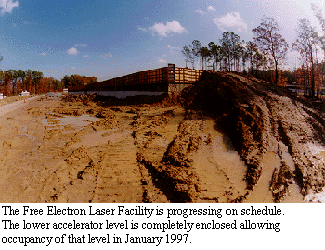



 |
|||||
| On Target (November & December 1996) | |||||
 |
 |
 |
|||
WORK IN PROGRESSSite grows to accommodate programs
In the spirit of technological advancement for the future that has made Jefferson Lab famous, several areas around the site are under construction. At each construction site the goal is to leave standing a new, highly efficient building, which will provide much needed office and work space. The Applied Research Center (ARC), which is under construction through a collaborative effort by Jefferson Lab, the city of Newport News, and several local universities, is scheduled to be completed by November 1997. According to Tom Dunn, Plant Engineering Director, the construction is proceeding on time, and much progress has been made with the building and parking lot this month. Dunn also said meetings between the contractor, the City of Newport News, and Jefferson Lab frequently take place in order to share up-to-date information on the status of the construction. The Accelerator Technical Support Building (ATS), which began construction
in early June 1996, was completed in December 1996. According to Bill
Kozma of the Accelerator Division, the ATS will house technical groups that
are responsible for the operation and maintenance of the accelerator. Among
those groups are the Cryogenics group and the High Power Electronics group.
These two groups will move into the building in January or February of
1997. Other groups, including Radiation Control and Safety Systems, will
also occupy the building.
The Free Electron Laser Facility (FEL) also began construction in June, and
has an estimated completion date of August 1997. The building will house
the Free Electron Laser and all personnel who will use and operate it.
According to George Neil, FEL Deputy Program Manager, the laser is expected
to supply 2,000 hours a year of light. There will be at least seven
operational labs in the building, including a lab reserved for use by
Dupont, one for metal machining, one for propagation and damage effects
testing, and one for micro machining. Two labs are yet to be committed.
"It's going to have just what industry wants to see - that is a laser
source that we can run with a set of user labs upstairs where they can
bring materials and test them out," said Neil.
|